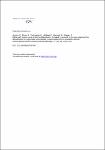bdhA-patD operon as a virulence determinant, revealed by a novel large-scale approach for identification of Legionella pneumophila mutants defective for amoeba infection.
Aurass, Philipp
Pless, Birgit
Rydzewski, Kerstin
Holland, Gudrun
Bannert, Norbert
Flieger, Antje
Legionella pneumophila, the causative agent of Legionnaires' disease, is an intracellular parasite of eukaryotic cells. In the environment, it colonizes amoebae. After being inhaled into the human lung, the bacteria infect and damage alveolar cells in a way that is mechanistically similar to the amoeba infection. Several L. pneumophila traits, among those the Dot/Icm type IVB protein secretion machinery, are essential for exploiting host cells. In our search for novel Legionella virulence factors, we developed an agar plate assay, designated the scatter screen, which allowed screening for mutants deficient in infecting Acanthamoeba castellanii amoebae. Likewise, an L. pneumophila clone bank consisting of 23,000 transposon mutants was investigated here, and 19 different established Legionella virulence genes, for example, dot/icm genes, were identified. Importantly, 70 novel virulence-associated genes were found. One of those is L. pneumophila bdhA, coding for a protein with homology to established 3-hydroxybutyrate dehydrogenases involved in poly-3-hydroxybutyrate metabolism. Our study revealed that bdhA is cotranscribed with patD, encoding a patatin-like protein of L. pneumophila showing phospholipase A and lysophospholipase A activities. In addition to strongly reduced lipolytic activities and increased poly-3-hydroxybutyrate levels, the L. pneumophila bdhA-patD mutant showed a severe replication defect in amoebae and U937 macrophages. Our data suggest that the operon is involved in poly-3-hydroxybutyrate utilization and phospholipolysis and show that the bdhA-patD operon is a virulence determinant of L. pneumophila. In summary, the screen for amoeba-sensitive Legionella clones efficiently isolated mutants that do not grow in amoebae and, in the case of the bdhA-patD mutant, also human cells.
No license information

